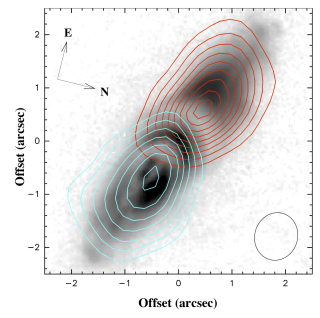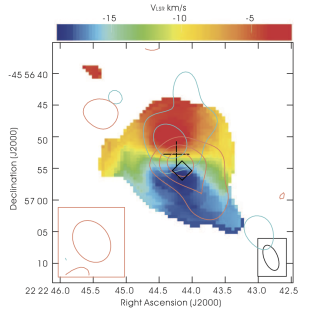|
Mass-loss phenomenon / Outflow properties
Most of the papers are in the category of mass-loss and outflows. SMA mapping of CO emission with angular resolution of 1" ~ 4" has revealed the kinematic structure of the outflows for the first time. High velocity (~100 km/s) bipolar molecular jets are seen perpendicular to expanding disk-like structures (tori) in V Hya (Hirano et al. 2004), IRAS 22036+5306 (Sahai et al. 2006), NGC 6302 (Peretto et al. 2007; Trung et al. 2008) and π Gru (Chiu et al. 2006) (See Figures 1 and 2). Evidence of episodic mass loss is found in observations of IRC+10420 (Trung et al. 2009b), and multiple outflows are detected in VY CMa (Muller et al. 2007) and IRAS 08544-4431 (Trung 2009a). All of these investigations address the question of how bipolarity arises from an initially spherically symmetrical mass-loss process in AGB stars as they evolve towards the proto-planetary nebula phase. In the case of IRAS 07134+1005, it appears that the torus structure precedes the formation of bipolar outflow (Nakashima et al. 2009). Another example of such a torus structure, with the polar directions being cleared away by a high-velocity outflow, is seen in NGC 7027 (Nakashima et al. 2010).
 |
Click here for larger view |
Figure 1: Map of CO 3-2 emission showing the red and blue wings of the outflow in IRAS 22036+5306, overlaid on a 0.6 micron HST image (Sahai et al. 2006). |
 |
Click here for larger view |
Figure 2: Intensity-weighted mean-velocity color map of the CO 2-1 emission from π1 Gru. The red and blue shifted lobes of the outflow are shown as contours. The cross and diamond indicate the locations of π1 Gru and its companion, respectively. (Chiu et al. 2006). |
The mass loss process in oxygen rich envelopes is less well understood compared to carbon rich envelopes. Observations and modeling of HCN emission in the oxygen rich star W Hya (Muller et al. 2009) shows the velocity profile as a function of radius to be increasing linearly, while the standard theoretical model predicts a rapid acceleration (caused by formation of dust and subsequent radiation pressure).
The dependence of mass-loss rate on metallicity is not well understood. AGB stars in the Galactic Bulge provide a good opportunity for studying this dependence. From a sample of such AGB stars in the galactic center region, CO emission was detected in two of the sources with the SMA (Winnberg et al. 2009). A follow up study to detect more sources is currently underway (Meixner et al. 2010, in preparation).
» Next Page: Inner Envelope; Dust formation
« Previous Page
SMA Research
| 


